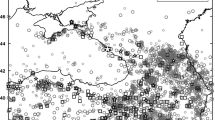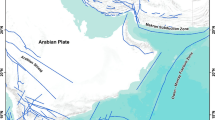Abstract
The Cornell and Gumbel approaches to probabilistic seismic hazard assessment have been applied in northeastern Italy to test the influence of various input parameters. Problems related to earthquake source geometry, seismicity descriptors, and attenuation of two ground-motion parameters of engineering interest (peak ground acceleration and macroseismic intensity) have been analyzed. The results seem to be very sensitive to this last variable (attenuation), while different methodologies can lead to very similar evaluations, if properly applied. Properly applied means that all the input parameters are prepared to satisfy the conditions of the chosen approach. In addition, the seismotectonic knowledge of the study region conditions the choice of approach to be applied.
Similar content being viewed by others
References
Al Abbasi, J. N. and Fahmi, K. J.: 1991, Gempack: a Fortran-77 program for calculating Gumbel's first, third and mixture upper earthquake magnitude distributions employing maximum likelihood estimation,Computers & Geosciences 17, 271–290.
Algermissen, S. T. and Perkins, D. M.: 1976a, A probabilistic estimate of maximum acceleration in rock in the contiguous United States, U.S. Geological Survey, Open File Report 76–416.
Algermissen, S. T., Perkins, D. M., Isherwood, W., Gordon, D., Reagor, G., and Howard, C.: 1976b, Seismic risk evaluation of the Balkan region, inProc. Seminar on Seismic Zoning Maps, Unesco, Skopje, pp. 172–240.
Ambraseys, N. N. and Bommer, J. J.: 1991, The attenuation of ground accelerations in Europe,Earth. Eng. Struct. Dyn. 20, 1179–1202.
Barbano, M. S., Egozcue, J. J., Garcia Fernandez, M., Kijko, A., Lapaine, J., Mayer-Rosa, D., Schenk, V., Schenkova, Z., Slejko, D., and Zonno, G.: 1989, Assessment of seismic hazard for the Sannio-Matese area of southern Italy - a summary,Natural Hazards 2, 217–228.
Bender, B. and Perkins, D. M.: 1987,Seisrisk III: a computer program for seismic hazard estimation, U.S. Geological Survey Bulletin 1772.
Berardi, R., Magri, L., and Mucciarelli, M.: 1990, Differenze di interpretazione di dati macrosismici da parte di diversi esperti e programmi per computer, in9° Conv. Naz. GNGTS. Riassunti delle Comunicazioni. ESA, Rome, p. 8.
Campbell, K. W.: 1989, The dependence of peak horizontal acceleration on magnitude, distance and site effects for small-earthquakes in California and Eastern North America,Bull. Seism. Soc. Amer. 79, 1311–1346.
Chiaruttini, C. and Siro, L.: 1981, The correlation of peak ground horizontal acceleration with magnitude, distance, and seismic intensity for Friuli and Ancona, Italy and the Alpide belt,Bull. Seism. Soc. Amer. 71, 1993–2009.
Cornell, C. A.: 1968, Engineering seismic risk analysis,Bull. Seism. Soc. Amer. 58, 1583–1606.
Drei, A., Grandori, G., Molina, C., Mulas, M., Perotti, F., and Petrini, V.: 1988, Individuazione delle principali aree sismogenetiche italiane e valutazione, per ciascuna area, della legge frequenza intensità epicentrale e della legge di attenuazione. Professional technical report, Politecnico Milano.
Epstein, B. and Lomnitz, C.: 1966, A model for the occurrence of large earthquakes,Nature 211, 954–956.
Giorgetti, F.: 1976, Isoseismal map of the May 6, 1976 Friuli earthquake,Boll. Geof. Teor. Appl. 18, 707–714.
Grandori, G., Perotti, F., and Tagliani, A.: 1987, On the attenuation of macroseismic intensity with epicentral distance, in A. S. Cakmak (ed.)Ground motion and Engineering Seismology, Developments in Geotechnical Engineering 44, Elsevier, Amsterdam, pp. 581–594.
Gumbel, E. J.: 1954,Statistical Theory of Extreme Value and Some Practical Applications. U.S. Dep. Commerce, Appl. Math. Ser. 3.
Gumbel, E. J.: 1958, Statistics of Extremes, Columbia Univ. Press, New York.
Joyner, W. B. and Boore, D. M.: 1981, Peak horizontal acceleration and velocity from strong-motion records including records from the 1979 Imperial Valley, California, earthquake,Bull. Seism. Soc. Amer. 71, 2011–2038.
Karnik, V.: 1969,Seismicity of the European Area Vol. 1, D. Reidel Dordrecht.
Knopoff, L. and Kagan, Y.: 1977, Analysis of the theory of extremes as applied to earthquake problems,J. Geophys, Res. 82, 5647–5657.
Lee, V. W. and Trifunac, M. D.: 1985, Uniform risk spectra of strong earthquake ground motion: NEQRISK, Report No. CE85-05, Dept. of Civil Eng., Univ. of Southern California, Los Angeles.
Makropoulos, K. C. and Burton, P. W.: 1985, Seismic hazard in Greece. II. Ground acceleration,Tectonophysics 117, 259–294.
Makropoulos, K. C. and Burton. P. W.: 1986, HAZAN: a Fortran program to evaluate seismic hazard parameters using Gumbel's theory of extreme value statistics,Computer & Geosciences 12, 29–46.
McGuire, R. K.: 1976, Fortran computer program for seismic risk analysis, U,S. Geological Survey, Open File Report 76–67.
McGuire, R. K.: 1978, FRISK: computer program for seismic risk analysis using faults as earthquake sources, U.S. Geological Survey Open File Report 78–1007.
Monachesi, G., Peruzza, L., Slejko, D., and Stucchi, M.: 1991, Seismic hazard assessment using intensity point data, in IBF (ed.)Soil Dynamics and Earth. Engin., Comp. Mech. Publ., Southampton, in press.
OGS: 1987, Earthquake catalogue for the Eastern Alps region, OGS, Trieste, computer file.
Papoulia, J. E. and Slejko, D.: 1989, Seismic hazard assessment in Friuli (NE Italy) with tentative fault geometry hypotheses, inProc. 4th Int. Symp. Analysis of Seismicity and Seismic Risk, Geoph. Inst. Czech. Ac. Sci., Prague, pp. 504–511.
Papoulia, J. and Slejko, D.: 1992, Cautious neotectonic hypotheses for assessing the seismic hazard in northeastern Italy,Natural Hazards 5, 249–268.
Peronaci, M.: 1982, Intensity-magnitude relationships for Italian regions,Boll. Geof. Teor. Appl. 24, 121–128.
Peruzza, L., Monachesi, G., Slejko, D., and Stucchi, M.: 1991, Valori osservati e valori calcolati per la stima della pericolosità sismica, in10° Conv. Naz. GNGTS, Riassunti delle Comunizazioni. ESA, Rome, pp. 17–18.
Richter, C. F.: 1958,Elementary Seismology, Freeman, San Francisco.
Risk Engineering Inc.: 1987a,Seismic Hazard Methodology for the Central and Eastern United States. Volume 2: Programmer's Manual, Electric Power Research Institute, N.NP-4726-CCMP.
Risk Engineering Inc.: 1987b,Seismic Hazard Methodology for the Central and Eastern United States. Volume 3: User's Manual. Electric Power Research Institute, N.NP-4726-CCMP.
Sabetta, F. and Pugliese, A.: 1987, Attenuation of peak horizontal acceleration and velocity from Italian strong-motion records,Bull. Seism. Soc. Amer. 77, 1491–1513.
Slejko, D., Carulli, G. B., Nicolich, R., Rebez, A., Zanferrari, A., Cavallin, A., Doglioni, C., Carraro, F., Castaldini, D., Iliceto, V., Semenza, E., and Zanolla, C.: 1989, Seismotectonics of the eastern Southern-Alps: a review,Boll. Geof. Teor. Appl. 31, 109–136.
Slejko, D. and Kijko, A.: 1991, Seismic hazard assessment for the main seismogenic zones in the Eastern Alps,Tectonophysics 191, 165–183.
Slejko, D. and Viezzoli, D.: 1984, Scuotibilità del Friuli - Venezia Giulia utilizzando tecniche anisotropiche, inAtti 3° Conv. Naz. GNGTS, ESA, Rome, pp. 829–842.
Sponheuer, W.: 1960, Berechnungverfahren mit schrittweiser Nährung, in W. Sponheuer (ed.),Methoden zur HerdtiefenBestimmung in der Makroseismik, Freiberger Forshungschefte C88, Akademie-Verlag, Berlin, pp. 16–32.
Author information
Authors and Affiliations
Rights and permissions
About this article
Cite this article
Peruzza, L., Slejko, D. Some aspects of seismic hazard assessment when comparing different approaches. Nat Hazards 7, 133–153 (1993). https://doi.org/10.1007/BF00680427
Received:
Revised:
Issue Date:
DOI: https://doi.org/10.1007/BF00680427




